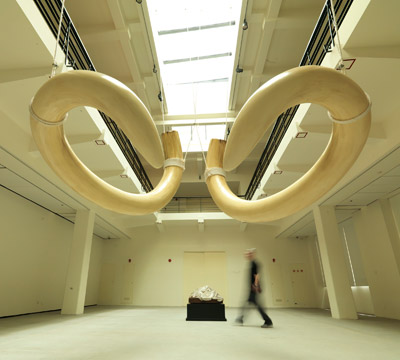2010 ZENG FANZHI
| December 1, 2010 | Post In LEAP 6

Zeng Fanzhi’s exhibition of paintings and sculptures at the Rockbund Art Museum in Shanghai (curated by Wu Hung) fills the building’s three stories as well as a nearby church. On a wall of the museum’s ground floor hangs a ripe, oozingly gorgeous oil-on-linen painting of a slaughtered lamb carcass, a fresh reminder of the artist’s Hubei roots (when he became known for painting pictures of butchered meat). Up the stairs, in a foyer outside the gallery, sits a wooden sculpture of a slaughtered lamb on a block (butcher’s block, altar?), its head and feet chopped off, mostly covered by an off-white (also wooden) blanket. Inside, two enormous dark canvases flank the space, each depicting Zeng’s trademark smoldering nightscapes, overgrown with tangled webs of branches (long, dragged brushstrokes) menaced by ravenous hyenas and spooked by anxious, half-concealed monkeys whose runty little faces look like embryonic Peking Opera masks. There is something amiss in paradise.
One flight up, the third-floor gallery is dominated by a sense of prehistoric absence: a pair of life-size Mammoth tusks—handcrafted from layers of wood but visually identical to ivory—hang suspended from the ceiling as if still attached to the now extinct animal. On the floor behind the dangling tusks sits another wooden chopping block with another wooden blanket completely covering what appears to be a bloodless mound of slaughtered animals, probably lambs, but possibly human corpses. The mound is ambiguous enough to be disturbing.
Of particular interest are the wooden sculptures of blanketed sacrifice. They are carved from a rare and expensive Chinese wood that plays the double role of literally being itself (a block of wood) while appearing to be an image of something else (a chopping block, an altar, a lamb carcass, or a blanket). Material reality and pictorial illusionism share the same super-refined surface, inciting between them a tension that is only resolved by the artisanal touch as it exposes the actual wood or represents an image on that wood—in this case, an image of something lying dead beneath a blanket. Both carved and stained, sculpted and rendered, the folds of that blanket—or the chopped-off feet of the lamb, or the laminated protein layers of the tusks—are offered as pictures as much as physical objects, and this is key to understanding these new sculptures: they are Western neo-classical paintings by other means.
What Zeng Fanzhi’s sculptures share with his paintings is a sense of rapturous repression, of something smoldering beneath their tastefully exquisite surfaces. Zeng’s hand has always been tasteful, especially if one understands taste as a form of genteel repression. For every expressionistic slab of bloody meat or field of burning embers in his oeuvre there is a crisply pressed business suit, a polished pair of black shoes, an antique European frame, a boy’s soft face, or, as in this show, blocks of rare wood that look like the drapery of a Christian saint. Taken as a whole, these few paintings and sculptures evoke themes of sacrifice, apocalypse, mutation, and some form of aesthetic transcendence of the material world.
The artist speaks of the different styles in which he paints as “periods” in his relatively short career. Pretense aside, Zeng Fanzhi has deployed his works at the Rockbund—from floor to floor, from museum to nearby church—as if to indicate something symphonic and Baroque. Barbara Pollack has recently, and famously, said that what Chinese artists added to the international art scene was scale. Because China is big, its art is big too. By Chinese standards, Zeng has never really made big art, but with his Rockbund show he crosses the line by making a bid for transcendence. Transcendence is bigger than big (and bigger than art)—it fills up museums and churches before vanishing into religion and myth. Overall, it’s pretty obvious that this show represents the aftermath of human history in a degraded environment. The hyenas are circling and the monkeys are watching. But it’s hard to take this green critique seriously when the show is really about the afterlife of taste, which, in Zeng’s aestheticized vision of apocalypse, is the ultimate form of transcendence. Jeff Kelley

